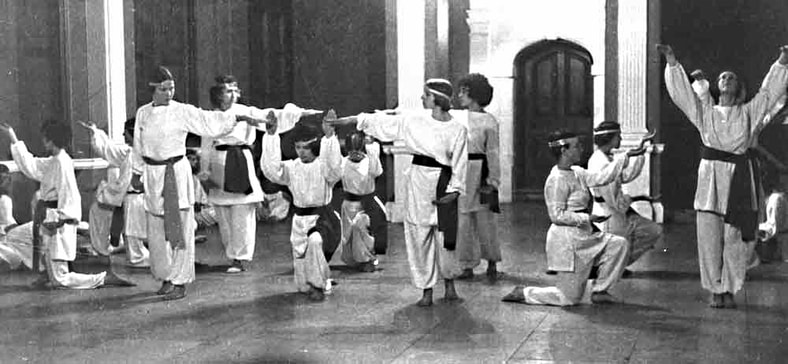Movements
THE MOVEMENTS
Gurdjieff introduced a fairly large number of “sacred dances” that are usually referred to as The Movements. Some were, he indicated, temple dances that he had encountered in his various travels and was able to recall. Others he invented himself.
The music played during the movements is piano music, jointly composed by Thomas De Hartmann and Gurdjieff. The movements could be thought of as “objective art” of a kind. To know whether that is true one has to participate rather than watch. Gurdjieff introduced hundreds of movements, so it is difficult to generalize about them. Some are strenuous, some are complex, some are fast, some are slow.
To perform them correctly requires the ability to harmonize the activity of the three centers; thinking, emotional and moving-instinctive. The physical postures that the dancers adopt in the movements are often entirely new, in the sense that one has never taken up that specific posture before. Also the movement of the body from one posture to another will also be a movement one has never executed before.
It may be the case that such movements, in combination with the music to which they are performed, provoke emotions and thoughts that are new, or if not new, then rare. Many Gurdjieff groups have associated movements teachers who keep the tradition of the movements alive.
Sacred Dances are essentially a mode of communication. They can transmit a universal language that promotes a deeper understanding of being.
The Movements created by Gurdjieff are uniquely his own and are a spiritual legacy of incalculable significance.
HISTORY
The Movements were created by Gurdjieff during the period of his life from:
The early Movements - 1918 until 1924
The later Movements - 1939 until 1949.
Gurdjieff Movements can be divided into seven categories:
-Rhythms
-The six 'Obligatories'
-Ritual exercises
-Woman Dances
-Men's ethnic dances-'dervish' and Tibetan
-Sacred temple dances and Tableaux
-Thirty-nine Series of Movements (partially enneagrammatic series)
The early Movements he created are all in the first six categories, and they were performed on stage in 1923 in Paris and in 1924 in America.
The later Movements are all in the last category or the Thirty-nine Series. These are a selection made by Gurdjieff out of exercises given by him during the last period of his life, from 1939 until his death in 1949.
Gurdjieff taught movements classes for different groups of people almost everyday, as he was approaching the last decade of his life until his death.
Today his 250 or so assembled 'Movements' represent to many of us the Work's immaculate heart.


